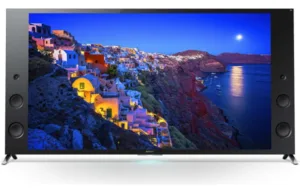Did you know that Sony has had TVs in the market for a year that can display content with expanded contrast and wider color gamut? Sounds like HDR right, well it is – sort of. The TVs, with two more coming in this year’s lineup, can take standard dynamic range content and expand the contrast and color gamut using internal processing to show HDR images.
Sony calls this capability X-tended Dynamic Range Pro, and it is a mode that can be engaged on the TV. According to Sony Product Technology Manager, Phil Jones, Sony expands the contrast – making the whites brighter and blacks darker, using a database to help fill in details and colors over this expanded range. It is a similar concept to what they employ when scaling HD resolution content to UHD resolution.
It does this by using a direct LED backlight with dynamic dimming that can lower luminance levels in darker regions. It also applies a boost to the backlight in very bright regions.
The 2015 models will be the 65X930C and the 75X940C at 65” and 75”. These should ship in May but can be pre-ordered for around $4,500 and $8,000 respectively. An 85” 2014 model is still offered with these capabilities for around $25K.
What is nice about the Sony sets is that there is also the “cinema pro” mode that is tuned to a peak luminance of 100 nits, D65 white point and rec 709 color gamut. That allows content mastered to this level – which is nearly everything – to be played back just as the director intended. But you can also engage the X-tended Dynamic Range Pro mode to see how the set processes the content to create the HDR version.
These UHD TVs will also playback native HDR-mastered content that will start streaming this year from Netflix and Amazon. According to Jones, the standard in which this HDR content will be distributed is still being finalized, but it is coming down to two camps. In one corner is Dolby with its DolbyVision solution and in the other is the UHD Alliance, which is a group of manufacturers and studios who are working hard to iron out differences and produce a standard. This is what Netflix and Amazon will use and it is what is going to become the standard for the next generation Blu-ray disc.
The UHD Alliance approach uses a single stream that will send the HEVC compressed HDR content to the TV, AVR or set top box. It is not backward compatible, but that is not an issue for OTT providers like Netflix and Amazon, explained Jones. These companies can determine the capabilities of the platform you are viewing the content on. If you have a 4K TV, Netflix will stream the 4K version if you have the bandwidth to support it. If you have a 4K TV with HDR, it will automatically stream this version.
A Blu-ray disc is likely to have both an SDR and HDR version on the media, playing back whichever version the display can support. The UHD Alliance is focused on a solution that will transport HDR content in UHD resolution, 10-bits per color, 4:2:0 sub sampling and 2020 color gamut.
Philips has demonstrated that they can master a HDR version and send this plus metadata to a home-based decoding device that could then pass the HDR version on or create an SDR version using the metadata. What is delivered depends upon the capabilities of the display.
Jones says that four of the five tasks the UHD Alliance is undertaking are mostly agreed to, but he declined to speculate on when they might be done. It is unclear if the Philips idea will be adopted either (maybe we will know more when Philips discusses this at Display Summit).
Sony has clearly made some decisions about the eventual distribution format the Alliance will adopt in order to get its TVs to market. Jones thinks they can adapt the TVs should there be some changes in the final format that they did not anticipate, so the TVs will not be obsolete once purchased.
The DolbyVision approach is a dual layer format with a backward compatible base layer carrying the SDR version and an enhancement layer to derive the HDR version. Content distributed in this format must have a DolbyVision decoder. So far, only the Vizio TVs will be able to playback this format. What that means for Netflix, Amazon and others is that they also must be able to detect a DolbyVision TV and then stream a DolbyVision version to those devices.
As we have noted before, the number of versions of a program that must now be created has grow dramatically in the last few years. Now you can add HDR versions to this growing list. (CC)

